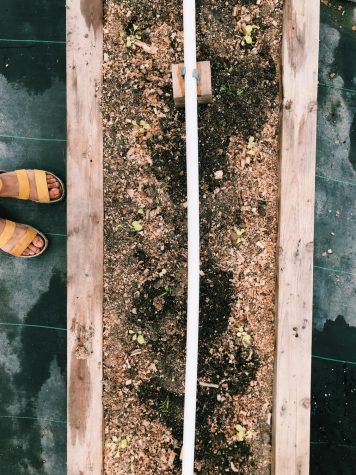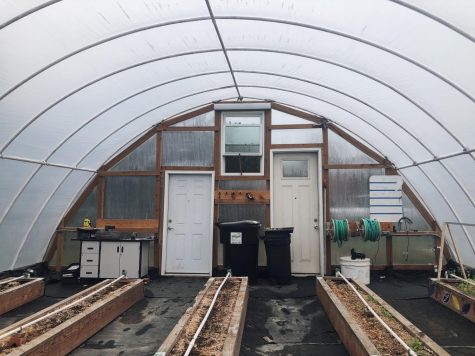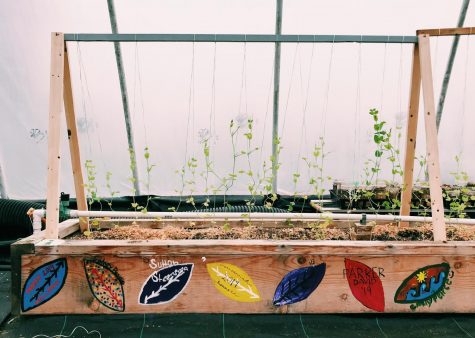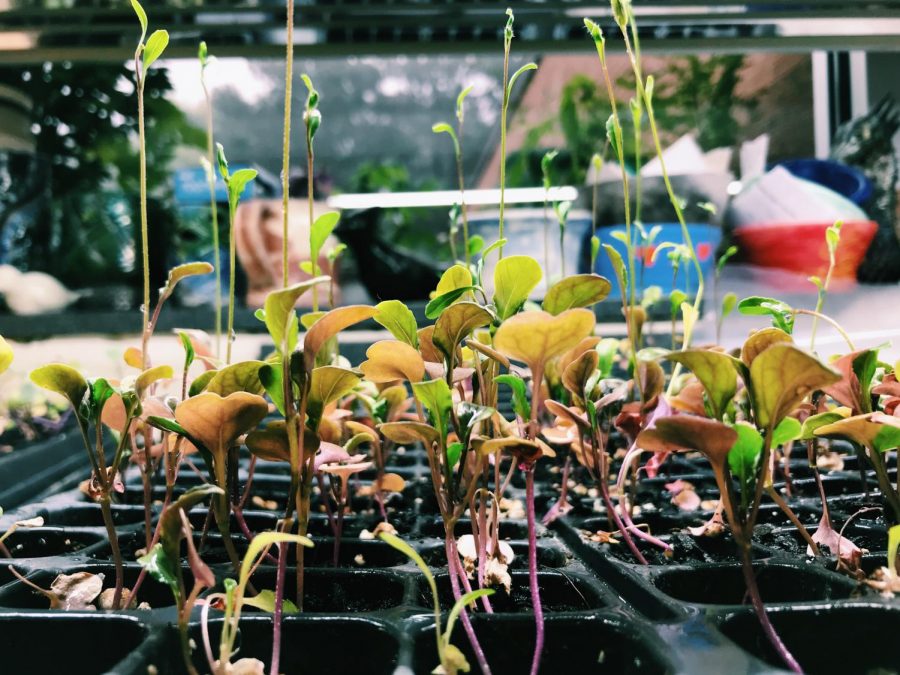Greenhouse Week 5 (Oct 1-5)
The more time I spend in the greenhouse, the more I love this opportunity that the other independent study students and I have. My time in the greenhouse, although limited, was wonderful, as cooler temperatures made it easier to work there. Besides the usual water of upstairs and downstairs flats, I did some planting throughout the week. I finished planting the last half of the flat with kohlrabi sprouts, started planting some different varieties of lettuce, and also did some companion planting with carrots. When I took AP Environmental Science (APES), companion planting was a technique of farming that we learned that greatly intrigued me. Essentially, it is planting multiple plants side by side so growers can be more productively planting in their limited space and also so that the different species can mutually benefit from each other. In the FHC greenhouse, we applied this principle in planting carrots next to the lettuce, which effectively maximizes spaces because the carrots grow down into the soil and the lettuce grows up and out (more or less). In addition to companion planting, I also replaced some of the lettuce sprouts that died in the boxes with new sprouts (from the inside flats).
I also did a lot of reading this week from two different books, and both are extremely interesting to me. The first book I’ve been consistently reading is The Omnivore’s Dilemma, and hours after reading my daily chapter, I would find myself still contemplating whatever I’d read. In APES, our class watched and read a lot about how much corn impacts many Americans in terms of diet, whether they realize it or not, and learning more about that through this book has been very enlightening and thought-provoking. The other book I’ve been reading is called Thirst by Scott Harrison, the founder of my favorite charity, charity: water. I can’t even summarize how much this book has changed my perspective about everything around me, but to be simply put, reading about Harrison’s journey in creating this charity is incredible. Access to clean water is such a prevalent issue, one that not many people realize because water is so readily available to most people; but in actuality, dirty water and lack of sanitation cause 52% of all illnesses in the developing world. Although I just finished Thirst, I’m very excited to keep reading from The Omnivore’s Dilemma and apply what I learn to the greenhouse.
Kara Bolger:
This week started out with a very enjoyable Monday. I was able to plant a flat of Morning Glories, a type of flower. While I love planting vegetables, I was very interested in trying something new, and I am super excited for them to grow!
On Tuesday, we planted arugula in boxes E 1,2, and 3. Arugula, like lettuce, needs to be planted about ten inches apart because of its size when it is fully grown. This allows us to plant about 24 sprouts in each box, meaning about 72 planted overall. On Wednesday, we went back through all the 12+ boxes we planted and looked for any open spots or dead plants in the boxes. With the high number of plants we are transferring, it is a given that some will lose roots or not make the transfer; so we replaced the open areas with lettuce. On Thursday, we emptied the Paper Gator bins, which is part of the paper recycling program at our school. We started doing it every two weeks now because they aren’t very full after just a week. Some of the bins are empty, so we are considering new spots to place them where more students will choose to recycle more of their papers. Friday consisted of perfect temperatures and rain. We planted Parris Island romaine in boxes B3, D2, and D3. We got to transfer lots of plants in fifty-degree weather while listening to the rain; it was a great end to the week.
Since we had a little bit of time this week, I got to read. The book I started is called, The Nature Principle by Richard Louv. I haven’t read too far into it, but I am already very excited. In just the first few pages of the book, I have already highlighted some very interesting and thought-provoking excerpts from the book. My favorites are, “The pleasure of being alive is brought into sharper focus when you need to pay attention to staying alive. Alive in the larger universe, alive in time” and “Nature can help us feel fully alive.” I will for sure keep the blog updated as I read this book, and I will share some more excerpts from the book as I come across them.
Olivia Bunnell:
This past week was a little bit slower than usual. All of the boxes have been planted in the greenhouse, so we decided to plant some flats of herbs to grow under the lights for the winter. Also, because the snap pea plants have been growing like weeds for the past several weeks, we built trellises for them to begin growing up. In a few weeks, we should be seeing peas growing off the vines. Now that we are finally settled in with our roles in the greenhouse, it should be smooth sailing from here on out, and it’ll be so cool to watch them develop over time.
Maria Finelli:
A typical day in the greenhouse consists of planting, watering, or filling flats in the art room; but this Monday, we had time to stop into the library and interview our new librarian Jaye Beeler. She told us all about her background in journalism and about her new book called Tasting and Touring Michigan’s Homegrown Food. She interviewed many different farmers in Michigan and talked a lot about how buying and eating fresh food is so much more beneficial than buying out-of-season fruits and veggies that are shipped in from far away places. It was super interesting getting to hear about her story.
Throughout the rest of the week, my daily tasks were more hands-on in the greenhouse. On Monday, I filled a flat with dirt, watered the flat, and carefully planted the tiny basil seeds just beneath the surface of the dirt. I checked on my flat yesterday, and the basil has already sprouted! On Tuesday, we planted kale in boxes E1, E2, and E3. We had a little bit of time at the end of the hour to read, and I’ve been reading a super interesting book about the issues with nature deficiency in children and adults called The Nature Principle. On Wednesday, we went through all of our boxes filled with different varieties of lettuce and replaced the plants that didn’t grow with fresh ones from the art room flats. Finally, on Thursday, we took out all of the Paper Gator bins containing the school’s recycled paper from the week, and at the end of the hour, we had more time to read independently. It was a very productive week!
Maddy Williams:
All the boxes are planted now! We had another productive week, and it is so exciting to walk into a full greenhouse and see the progress we’ve made in just a few short weeks. In the greenhouse, Maria, Kara, and I worked hard planting over six boxes with a variety of plants. We focused mostly on planting kale and three types of lettuce: Simpson Elite, baby romaine, and select salad.
In addition to the planting we did in the greenhouse, I planted a flat of cilantro, which is currently waiting under a grow light to sprout. I’ve been checking on it periodically this week, adding water, and there are already a few signs of plants beginning to grow!
As usual, the 5th-hour team took care of the Paper Gator recycling and compost. As a team, we’ve gotten faster and more efficient at both these tasks allowing us to have a little spare time at the end of the week. During our extra time, we had the opportunity to have an interesting conversation with one of Forest Hills Central’s new staff members: Jaye Beeler. She is our new librarian as well as the author of the book Tasting and Touring Michigan’s Homegrown Food. Ms. Beeler, along with photographer Dianne Carroll, took a “culinary road trip” around Michigan where she tasted and learned about food produced by locals. She went on this trip with what she said was “the intent to explore the homegrown goodness in our state” and discovered some amazing people, places, and foods along the way. Her description of the passion that each individual had for their practice and the food they produced really stood out to me. It was fascinating to hear about the great number of people who grow their own food in unique ways and have a genuine love for doing it. At one point in the interview, she mentioned a farm up north, Christmas Cove Farm, that grows more than 240 varieties of apples! It was surprising to hear about the vast quantity, while maintaining high quality, of foods produced by families and locals in our state. In just the conversation we shared with her, I gained a new perspective on the foods out there that we can enjoy supporting our home-state growers and producers. As I read through the book and attempt to explore some of the farms with the 5th-hour team, I will continue to reflect on tasty discoveries we make!



